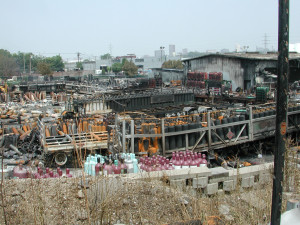A major fire broke out at a gas storage and bottling facility. Nearly 30,000 bottles (propane, propylene, oxygen, hydrogen, acetylene, carbon dioxide, helium, etc.) were being held onsite, split into 2 sections, one for full bottles the other for “returns” (i.e. empty or only partially filled). Around 3:20 pm, an employee noticed the presence of a 3-m high flame at the level of a propylene bottle and triggered the fire alarm. While the 22 employees and 2 clients were evacuating the premises, the fire spread to adjacent bottles; within 4 minutes, the fire had encompassed the entire zone occupied by inflammable gas bottles. Repeated explosions (of the BLEVE type) could be heard; blasts of fragments and bottles both inside the facility and extending 250 m beyond the site boundary caused additional fire outbreaks (i.e. a “domino effect”). Multiple fire sources, tall flames and a thick black smoke complicated the efforts of fire-fighters, who had arrived on the scene at 3:35 pm. The police evacuated a good number of industrial zone neighbours. The fire was finally brought under control around 8:30 that evening; nearly 8,000 bottles had burned.
Property damage sustained within the vicinity was extensive, including: 1 empty commercial building and parked vehicles burned, window panes shattered, a hole penetrated into the wall of a neighbouring residence etc. Asbestos stemming from acetylene bottles spread via the smoke; the zone would need to undergo decontamination. According to the medical authorities, one person died from an asthma attack due to smoke inhalation.
According to the body assigned to conduct the investigation (the US Chemical Safety Board, CSB), direct solar radiation coupled with radiant heat emanating from the asphalt ground layer on this extremely warm day (36°C) caused a rise in temperature, hence pressure, of the propylene, thereby activating opening of the safety valve and triggering the gas leak that subsequently ignited, most likely as the result of static electricity discharge. Following an analysis of 3 similar accidents occurring in 1997, 2003 and 2005 in the United States, the CSB discovered that the safety margin between the vapour saturating pressure and the safety valve set pressure was lower on the propylene bottles than on the propane ones. The Board issued, in conjunction with professional codes, a series of recommendations specific to: spatial organisation (storage zones allocated by risk group, identified, appropriately ventilated, placed far from the oxidants, sparks and open flames, etc.); warehouse equipment (fire protection, gas detection, projection prevention devices); and the setting and control of safety valves fitted on the propylene bottles.




